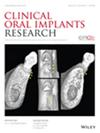新型水虎鱼钝化牙种植体表面对口腔生物膜形成的体外评估
IF 5.3
1区 医学
Q1 DENTISTRY, ORAL SURGERY & MEDICINE
引用次数: 0
摘要
背景与目的种植体周围炎是牙种植体细菌定植引起的一种重要并发症,是口腔保健领域的一大挑战。在促进组织整合的同时,开发抑制细菌粘附的表面对于改善种植体效果至关重要。本研究旨在利用体外多物种生物膜模型评估细菌在牙种植体钝化表面上的定植。材料与方法通过分析钝化处理后的粗糙度、接触角值和表面能,对三种类型的钛种植体(标准、柠檬酸钝化和水虎鱼钝化)进行了表征。利用定量聚合酶链反应(qPCR)、扫描电子显微镜(SEM)和共聚焦激光扫描显微镜(CLSM)评估这些植入物形成生物膜的能力。在6、12和24 h时评估细菌定植和活力。此外,还测定了这些表面的蛋白质吸附能力。结果处理提高了材料的亲水性和极性表面能,但粗糙度没有变化。虽然没有发现统计学上的显著差异,但与柠檬酸植入物相比,在食人鱼处理过的表面上观察到的初级和中级定殖菌浓度略低,特别是在24小时的孵育期间。CLSM分析显示,随着时间的推移,水虎鱼钝化的植入物上的死细菌比例更高。水虎鱼钝化也导致纤维蛋白原吸附最低。结论:水虎鱼钝化可能是一种很有前途的牙种植体表面处理方法,可能降低种植体周围炎的风险。然而,体外方法的固有局限性需要进一步的临床试验来验证这种表面修饰在现实世界临床环境中的有效性。本文章由计算机程序翻译,如有差异,请以英文原文为准。
In Vitro Assessment of a Novel Piranha‐Passivated Dental Implant Surface Against Oral Biofilm Formation
Background and ObjectivesPeri‐implantitis, a significant complication resulting from bacterial colonization on dental implants, presents a challenge in oral healthcare. Developing surfaces that inhibit bacterial adhesion while promoting tissue integration is crucial for improving implant outcomes. This study aims to evaluate bacterial colonization on a novel passivated surface for dental implants using an in vitro multispecies biofilm model.Materials and MethodsThree types of titanium implants (standard, citric acid‐passivated, and piranha‐passivated) were characterized by analyzing roughness, contact angle values, and surface energy after the passivation treatments. The capacity for biofilm formation on these implants was evaluated using quantitative polymerase chain reaction (qPCR), scanning electron microscopy (SEM), and confocal laser scanning microscopy (CLSM). Bacterial colonization and viability were assessed at 6, 12, and 24 h. In addition, the protein adsorption capacity of these surfaces was determined.ResultsTreatments increased hydrophilicity and polar surface energy, with no change in roughness. Although no statistically significant differences were found, a slightly lower concentration of primary and intermediate colonizers was observed on piranha‐treated surfaces compared to citric acid implants, particularly during the 24‐h incubation period. CLSM analyses revealed a higher percentage of dead bacteria on piranha‐passivated implants over time. Piranha passivation also resulted in the lowest fibrinogen adsorption.ConclusionThese findings suggest that piranha passivation may be a promising treatment for dental implant surfaces, potentially reducing the risk of peri‐implantitis. However, the inherent limitations of the in vitro approach necessitate further clinical trials to validate the efficacy of this surface modification in real‐world clinical settings.
求助全文
通过发布文献求助,成功后即可免费获取论文全文。
去求助
来源期刊

Clinical Oral Implants Research
医学-工程:生物医学
CiteScore
7.70
自引率
11.60%
发文量
149
审稿时长
3 months
期刊介绍:
Clinical Oral Implants Research conveys scientific progress in the field of implant dentistry and its related areas to clinicians, teachers and researchers concerned with the application of this information for the benefit of patients in need of oral implants. The journal addresses itself to clinicians, general practitioners, periodontists, oral and maxillofacial surgeons and prosthodontists, as well as to teachers, academicians and scholars involved in the education of professionals and in the scientific promotion of the field of implant dentistry.
 求助内容:
求助内容: 应助结果提醒方式:
应助结果提醒方式:


